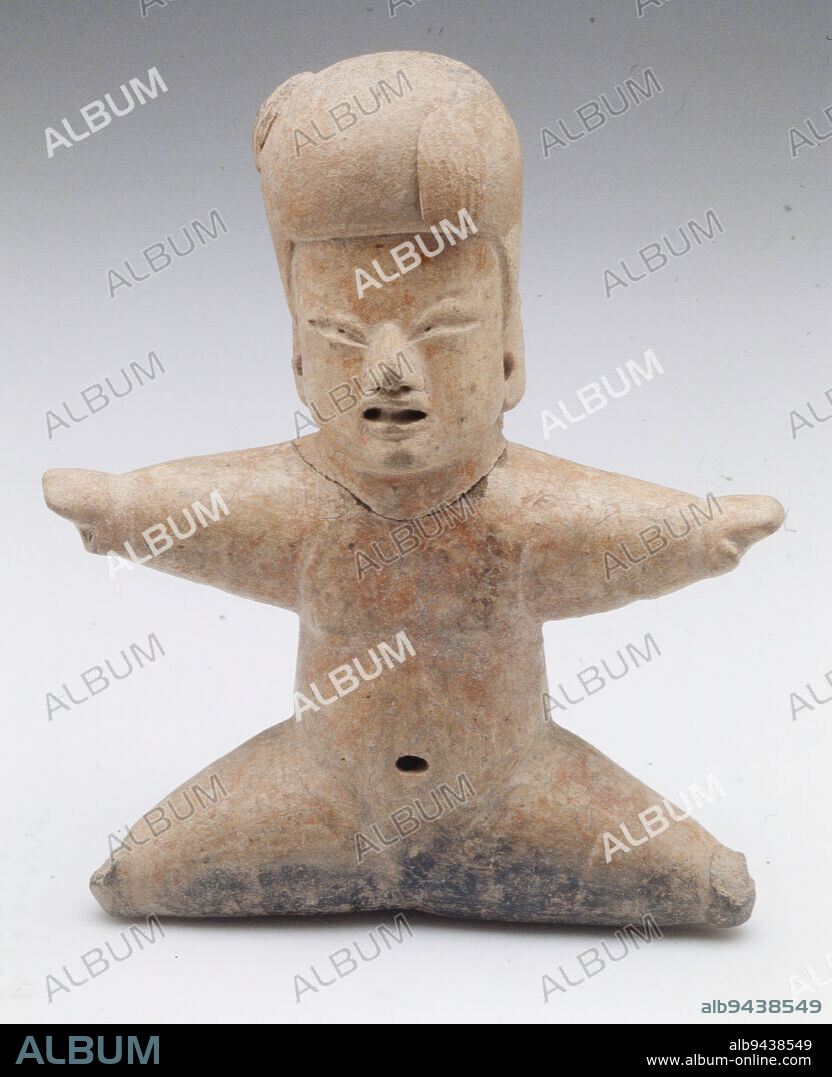alb9438549
Figure, 11th-6th century BCE, 8 7/8 x 7 in. (22.54 x 17.78 cm), Ceramic, Mexico, 11th-6th century BCE, The Olmec people developed the first cities of Mesoamerica. Situated in the tropical lowlands of Mexico, these early urban societies produced most of the major features of later regional civilizations: monumental architecture and sculpture, hieroglyphic writing, a calendrical system, and intensive agriculture. The distinctive Olmec art style, expressive of their religion, greatly influenced subsquent Mesoamerican art.A prominent motif in Olmec art is the 'baby face,' a fleshy human face with drooping mouth, squinting eyes, and snub nose. Here the distinctive features are part of a naturalistic depiction, but in many Olmec pieces they merge with feline traits like snarling lips and fangs. These pervasive references to the spiritual union of a jaguar and a human allude to an Olmec conception of the supernatural status of rulers.

|
Add to another lightbox |
|
Add to another lightbox |



Buy this image.
Select the use:

Caption:
Figure, 11th-6th century BCE, 8 7/8 x 7 in. (22.54 x 17.78 cm), Ceramic, Mexico, 11th-6th century BCE, The Olmec people developed the first cities of Mesoamerica. Situated in the tropical lowlands of Mexico, these early urban societies produced most of the major features of later regional civilizations: monumental architecture and sculpture, hieroglyphic writing, a calendrical system, and intensive agriculture. The distinctive Olmec art style, expressive of their religion, greatly influenced subsquent Mesoamerican art.A prominent motif in Olmec art is the 'baby face,' a fleshy human face with drooping mouth, squinting eyes, and snub nose. Here the distinctive features are part of a naturalistic depiction, but in many Olmec pieces they merge with feline traits like snarling lips and fangs. These pervasive references to the spiritual union of a jaguar and a human allude to an Olmec conception of the supernatural status of rulers.
Credit:
Album / quintlox
Releases:
Image size:
4003 x 4929 px | 56.5 MB
Print size:
33.9 x 41.7 cm | 13.3 x 16.4 in (300 dpi)
Keywords:
11TH-6TH CENTURY BCE • BABY FACE • CALENDRICAL SYSTEM • CERAMIC • CERAMICS • CLAY • DISTINCTIVE FEATURES • DISTINCTIVE OLMEC ART STYLE • DROOPING MOUTH • EARLY URBAN SOCIETIES PRODUCED • EXPRESSIVE • FANGS • FELINE TRAITS • FIGURE • FIRST CITIES • FLESHY HUMAN FACE • GREATLY INFLUENCED SUBSQUENT MESOAMERICAN ART. A PROMINENT MOTIF • HIEROGLYPHIC WRITING • HUMAN ALLUDE • INTENSIVE AGRICULTURE • JAGUAR • KERAMEIKOS • LATER REGIONAL CIVILIZATIONS • MAJOR FEATURES • MERGE • MESOAMERICA • MESOAMERICAN • MEXICO • MONUMENTAL ARCHITECTURE • NATURALISTIC DEPICTION • OLMEC ART • OLMEC CONCEPTION • OLMEC PEOPLE DEVELOPED • OLMEC PIECES • OUNCE (ANIMAL) • PART • PERVASIVE REFERENCES • POTTERIES • POTTERY • RELIGION • RULER (POLITICAL) • RULERS • SCULPTED • SCULPTING • SCULPTURE • SCULPTURE. • SCULPTURES • SCUPTURE • SITUATED • SNARLING LIPS • SNUB NOSE • SOVEREIGN (RULER) • SOVEREIGN • SPIRITUAL UNION • SQUINTING EYES • STONEWARE • SUPERNATURAL STATUS • TERRA COTTA • TERRACOTA • TERRACOTTA • TROPICAL LOWLANDS


 Pinterest
Pinterest Twitter
Twitter Facebook
Facebook Copy link
Copy link Email
Email
